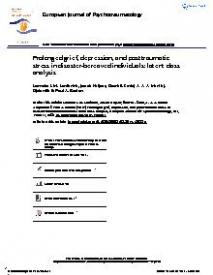Prolonged grief, depression, and posttraumatic stress in disaster-bereaved individuals : Latent class analysis
Background Hundreds of individuals lost one or more significant others in the MH17 plane crash in 2014 in Ukraine. The current study is the first to explore subgroups of disaster-bereaved individuals based on presence of psychopathology clusters. This may inform the development of diagnostic instruments and tailored interventions. Objective Aims of the current study were to examine (1) subgroups based on presence of Prolonged Grief Disorder (PGD), Major Depressive Disorder (MDD), and Posttraumatic Stress Disorder (PTSD) symptom clusters and (2) associations between class membership, disaster-related variables (i.e., experiencing multiple losses, conducting multiple burials for the same deceased, and time to confirmation of death), and a sense of unrealness. Method Self-rated PGD (10 items of the Traumatic Grief Inventory represented in two symptom clusters), MDD (16-item Quick Inventory of Depressive Symptomatology represented in one symptom cluster), and PTSD (20-item PTSD Checklist for DSM-5 represented in four symptom clusters) from 167 participants were subjected to latent class analysis to identify subgroups (i.e., classes). Correlates of class membership were assessed using the three-step approach. Results A three-class solution yielded the best model fit. Class 1 (Resilient class; 20.0%) was predominantly characterized by low probability of PGD, MDD, and PTSD symptom clusters, class 2 (PGD class; 41.8%) by moderate to high probability of presence of PGD, and class 3 (Combined class; 38.2%) by moderate to high probability of presence of PGD, MDD, and PTSD symptom clusters. Compared with the Resilient class, a sense of unrealness was more likely to be experienced by individuals in the PGD class and the Combined class. Conclusions Our results indicate that subgroups of disaster-bereaved individuals can be distinguished based on the presence of PGD, MDD, and PTSD symptom clusters. A sense of unrealness was the strongest distinguishing feature of the subgroups.
In: European Journal of Psychotraumatology, ISSN 2000-8066 | 8 | 1 | 1298311
http://dx.doi.org/10.1080/20008198.2017.1298311


